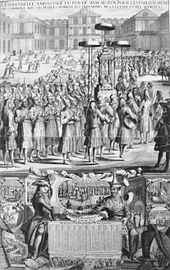
Hall of Mirrors, Palace of Versailles
The Hall of Mirrors (French: Grande Galerie or Galerie des Glaces) is the central gallery of the Palace of Versailles in Versailles, France.
As the principal and most remarkable feature of King Louis XIV of France's third building campaign of the Palace of Versailles (1678–1684), construction of the Hall of Mirrors began in 1678.[1][2][3][4][5][6] To provide for the Hall of Mirrors as well as the salon de la guerre and the salon de la paix, which connect the grand appartement du roi with the grand appartement de la reine, architect Jules Hardouin Mansart appropriated three rooms from each apartment as well as the terrace that separated the two apartments.[2][3][7]
The principal feature of this hall is the seventeen mirror-clad arches that reflect the seventeen arcaded windows that overlook the gardens. Each arch contains twenty-one mirrors with a total complement of 357 used in the decoration of the galerie des glaces.[7] The arches themselves are fixed between marble pilasters whose capitals depict the symbols of France. These gilded bronze capitals include the fleur-de-lys and the Gallic cockerel or rooster. Many of the other attributes of the Hall of Mirrors were lost to war for financial purposes, such as the silver table pieces and guéridons, which were melted by order of Louis XIV in 1689 to finance the War of the League of Augsburg.[7][8][9][10]
Construction

Gilded sculptured guéridons were commissioned to replace part of the silver furniture.
In the 17th century, mirrors were among the most expensive items to possess at the time; the Venetian Republic held the monopoly on the manufacture of mirrors. In order to maintain the integrity of his philosophy of mercantilism, which required that all items used in the decoration of Versailles be made in France, Jean-Baptiste Colbert enticed several workers from Venice to make mirrors at the Manufacture royale de glaces de miroirs. According to legend, in order to keep its monopoly, the government of the Venetian Republic sent agents to France to poison the workers whom Colbert had brought to France.[7]
The Hall of Mirrors' dimensions are 73.0 m × 10.5 m × 12.3 m (239.5 ft × 34.4 ft × 40.4 ft) and is flanked by the salon de la guerre (north) and the salon de la paix (south). Construction on the galerie and its two salons continued until 1684, at which time it was pressed into use for court and state functions. The ceiling decoration is dedicated to the political policies and military victories of Louis XIV. The central panel of the ceiling, Le roi gouverne par lui-même (The king governs alone) alludes to the establishment of the personal reign of Louis XIV in 1661. The present decorative schema represents the last of three that were presented to Louis XIV. The original decorative plan was to have depicted the exploits of Apollo, being consistent with the imagery associated with the Sun-King, Louis XIV. However, when the king learned that his brother, Philippe I, Duke of Orléans, had commissioned Pierre Mignard to decorate the ceiling of the grande galerie of his brother's residence at Château de Saint-Cloud, Louis XIV rejected the plan. The next decorative plan was one in which the exploits of Hercules — as allegories to the actions of Louis XIV — were to be depicted. Again, as with the first plan, the Hercules theme was rejected by the king. The final plan represents military victories of Louis XIV starting with the Treaty of the Pyrenees (1659) to the Treaty of Nijmegen (1678–1679). In a departure from the decoration of the ceilings in the grand appartement du roi, Le Brun has depicted Louis XIV directly, and has ceased to refer to the king in allegorical guises. In this way, themes such as good governance and military prowess are rendered with Louis XIV himself as the key figure.[3][7][11]
Functions
During the 17th century, the Hall of Mirrors was used daily by Louis XIV when he walked from his private apartment to the chapel. At this time, courtiers assembled to watch the king and members of the royal family pass, and might make a particular request by intoning: "Sire, Marly?".[12] This was the manner in which one was able to obtain a much sought-after invitation to one of the king's house parties at Marly-le-Roi, the villa Louis XIV built north of Versailles on the route to Saint-Germain-en-Laye. However, of all the events that transpired in this room during the reign of Louis XIV, the Siamese Embassy of 1685–1686 must be cited as the most opulent.[8][13][14][15] At this time, the galerie des glaces and the grands appartements were still appointed with silver furniture. In February 1715, Louis XIV held his last embassy in the galerie des glaces, one in which he received Mehemet Reza Bey, ambassador of the Shah of Persia.[13]
In the successive reigns of Louis XV and Louis XVI, the Hall of Mirrors continued to serve for family and court functions. Embassies, births, and marriages were fêted in this room; however, perhaps the most celebrated event of the 18th century occurred on 25 February 1745: the celebrated bal des Ifs (Ball of the Yew Trees). It was during this costume ball that Louis XV, who was dressed as a yew tree, met Jeanne-Antoinette Poisson d'Étiolles, who was costumed as Diana, goddess of the hunt. Jeanne-Antoinette, who became Louis XV's mistress, is better known to history as the Marquise de Pompadour.[16][17]
In the 19th century, at the conclusion of the Franco-Prussian War, the Prussian king, William I, was declared German emperor — thus establishing the German Empire on 18 January 1871 in the Hall of Mirrors by Bismarck and the victorious German princes and lords. This was seen as a victory with heavy symbolism for the Germans and a stinging insult for the defeated French. French Prime Minister Clemenceau chose the Hall of Mirrors to sign the Treaty of Versailles that ended World War I on 28 June 1919.
The Hall of Mirrors is still pressed into service for state occasions of the Fifth Republic, such as receptions for visiting heads of state.
Gallery
| Historical depictions of the Hall of Mirrors |
|---|
| Le roi gouverne par lui-même” modello for the central panel of the ceiling of the Hall of Mirrors ca. 1680 by Charles Le Brun, (1619–1690). |
| Reception of the Doge of Genoa, 15 May 1685 by Claude-Guy Hallé. In this painting we see some of Louis XIV's silver furniture, including his silver throne |
| The Signing of Peace in the Hall of Mirrors, Versailles, 28 June 1919, by William Orpen, 1919 |
| Ceiling of the Hall of Mirrors. |
|
| Example 1 |
Notes and references
- ↑ Fiske Kimball, "Mansart and LeBrun and the Genesis of the Grand Galerie de Versailles." The Art Bulletin volume 22, (March 1940): 1–6.
- ↑ 2.0 2.1 Alfred Marie, Naissance de Versailles. (Paris: Édition Vincet, Feal & Cie, 1968).
- ↑ 3.0 3.1 3.2 Alfred and Jeanne Marie, Mansart à Versailles. (Paris: Editions Jacques Freal, 1972).
- ↑ Pierre de Nolhac, La Création de Versailles. (Versailles: L. Bernard, 1901).
- ↑ Pierre de Nolhac, Versailles, Résidence de Louis XIV. (Paris: Louis Conrad, 1925).
- ↑ Pierre Verlet, Le Mobilier royal Français. (Paris: 1945).
- ↑ 7.0 7.1 7.2 7.3 7.4 Pierre Verlet, Le château de Versailles. (Paris: Librairie Arthème Fayard, 1985).
- ↑ 8.0 8.1 Marquis de Dangeau, (1854). Journal avec les additions inedites du duc de Saint-Simon, vol. 3 (1689–1692) (Paris: Firmin Didot Freres, 1854).
- ↑ Gabriel-Jules, comte de Cosnac, Mémoires du marquis de Sourches sur le règne de Louis XIV, (Paris: Librairie Hachette et Cie, 1984).
- ↑ Mercure galant. (December 1682; September 1686; December 1686).
- ↑ Jenifer Montagu, "Le Brun's Early Designs for the Grand Galerie: some comments on the drawings". Gazette des Beaux-Arts 6 pér., tome 120 (November 1992): 195–206.
- ↑ Jean-François Solnon, (1987). La Cour de France, (Paris: Fayard, 1987).
- ↑ 13.0 13.1 François Bluche, Louis XIV, Paris: Arthème Fayard, 1986).
- ↑ Dirk Van der Cruysse, (1991). Louis XIV et le Siam, (Paris: Arthème Fayard, 1991).
- ↑ Mercure galant. (September 1686; December 1686).
- ↑ Alfred Marie, Versailles au temps de Louis XV, (Paris: Imprimerie National, 1984).
- ↑ Pierre de Nolhac, Versailles au XVIIIe siècle, (Paris: Louis Conard, 1926).
Further reading
Books
- Bluche, François (1986). Louis XIV. Paris: Arthème Fayard.
- Bluche, François (1991). Dictionnaire du Grand Siècle. Paris: Arthème Fayard.
- Combes, sieur de (1681). Explication historique de ce qu'il y a de plus remarquable dans la maison royale de Versailles. Paris: C. Nego.
- Cosnac, Gabriel-Jules, comte de (1984). Mémoires du marquis de Sourches sur le règne de Louis XIV. Paris: Librairie Hachette et Cie.
- Cruysse, Dirk Van der (1991). Louis XIV et le Siam. Paris: Arthème Fayard.
- Dangeau, marquis de (1854). Journal avec les additions inedites du duc de Saint-Simon. vol. 3. (1689–1692). Paris: Firmin Didot Freres.
- Félibien, André (1694). La description du château de Versailles, de ses peintures, et des autres ouvrags fait pour le roy. Paris: Antoine Vilette.
- Félibien, Jean-François (1703). Description sommaire de Versailles ancienne et nouvelle. Paris: A. Chrétien.
- Marie, Alfred (1968). Naissance de Versailles. Paris: Édition Vincet, Feal & Cie.
- Marie, Alfred (1984). Versailles au temps de Louis XV. Paris: Imprimerie National.
- Marie, Alfred and Jeanne (1972). Mansart à Versailles. Paris: Editions Jacques Freal.
- Monicart, Jean-Baptiste de (1720). Versailles immortalisé. Paris: E. Ganeau.
- Nolhac, Pierre de (1901). La Création de Versailles. Versailles: L. Bernard.
- Nolhac, Pierre de (1925). Versailles, Résidence de Louis XIV. Paris: Louis Conrad.
- Nolhac, Pierre de (1926). Versailles au XVIIIe siècle. Paris: Louis Conrad.
- Nolhac, Pierre de (1929). Versailles. Paris: A. Morancé.
- Nolhac, Pierre de (1930). Versailles et la cour de France: L'Art à Versailles. Paris: Louis Conard.
- Nolhac, Pierre de (1937). La Résurrection de Versailles, souvenirs d'un conservateur, 1887–1920. Paris: Plon.
- Piganiol de la Force, Jean-Aymar (1701). Nouvelle description des châteaux et parcs de Versailles et Marly. Paris: Chez Florentin de la lune.
- Solnon, Jean-François (1987). La Cour de France. Paris: Fayard.
- Solnon, Jean-François (1997). Versailles. Paris: Éditions du Rocher.
- Verlet, Pierre (1945). Le mobilier royal Français. Paris.
- Verlet, Pierre (1985). Le château de Versailles. Paris: Librairie Arthème Fayard.
|
Journals
- Jacquiot, Joseph (1985). "Remarques critiques sur les inscriptions de la galerie de Versailles, par Boileau-Despéaux". Colloque de Versailles.
- Jestaz, Bertrand (1985). "Jules Hardouin-Mansart et ses dessinateurs". Colloque de Versailles.
- Josephson, Ragnar (1926). "Relation de la visite de Nicodème Tessin à Marly, Versailles, Rueil, et St-Cloud en 1687". Revue de l'Histoire de Versailles: 150–67, 274–300.
- Kimball, Fiske (March 1940). "Mansart and LeBrun and the Genesis of the Grand Galerie de Versailles". The Art Bulletin 22 (1): 1–6. doi:10.2307/3046675. JSTOR 3046675.
- Langner, Johannes (1982). "Le Brun interprête de l'histoire de Louis XIV: à propos d'un tableau de la Galerie des Glaces à Versailles". Formes. Spring: 21–26.
- Mercure galant. December 1682; September 1686; December 1686.
- Montagu, Jenifer (November 1992). "Le Brun's Early Designs for the Grand Galerie: some comments on the drawings". Gazette des Beaux-Arts. 6 pér., tome 120: 195–206.
- Montagu, Jenifer (August 1963). "The Early Ceiling Decorations of Charles Le Brun". The Burlington Magazine CV (725): 365–408.
- Montagu, Jenifer (1968). "The Painted Enigma and French Seventeenth-century Art". Journal of the Warburg and Courtauld Institutes (Journal of the Warburg and Courtauld Institutes, Vol. 31) 31: 307–335. doi:10.2307/750646. JSTOR 750646.
- Nolhac, Pierre de (1899). "La construction de Versailles de Le Vau". Revue de l'Histoire de Versailles: 161–171.
- Sabatier, Gérard (1985). "Versailles, ou le sens perdu, manière de montrer la galerie des glaces aux 17e et 18e siècles". Colloque de Versailles.
- Verlet, Pierre (1985). "Les guéridons de la Galerie des Glaces". Bulletin de la société de l'art français: 129–135.
|
External links
 Media related to Hall of Mirrors (Palace of Versailles) at Wikimedia Commons
Coordinates: 48°48′17.4″N 2°7′13.2″E / 48.804833°N 2.120333°E / 48.804833; 2.120333
Media related to Hall of Mirrors (Palace of Versailles) at Wikimedia Commons
Coordinates: 48°48′17.4″N 2°7′13.2″E / 48.804833°N 2.120333°E / 48.804833; 2.120333


![]() Media related to Hall of Mirrors (Palace of Versailles) at Wikimedia Commons
Coordinates: 48°48′17.4″N 2°7′13.2″E / 48.804833°N 2.120333°E
Media related to Hall of Mirrors (Palace of Versailles) at Wikimedia Commons
Coordinates: 48°48′17.4″N 2°7′13.2″E / 48.804833°N 2.120333°E
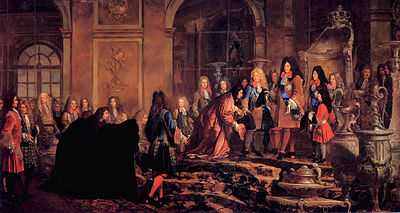
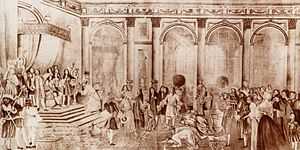
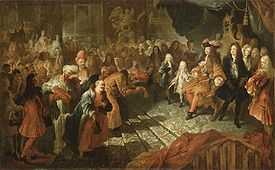

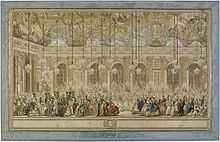
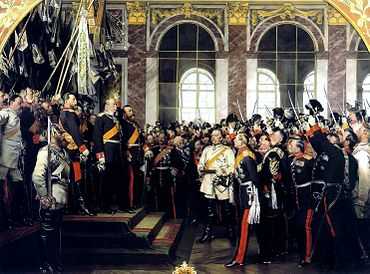
_(RA)_-_The_Signing_of_Peace_in_the_Hall_of_Mirrors%2C_Versailles%2C_28th_June_1919_-_Google_Art_Project.jpg)

